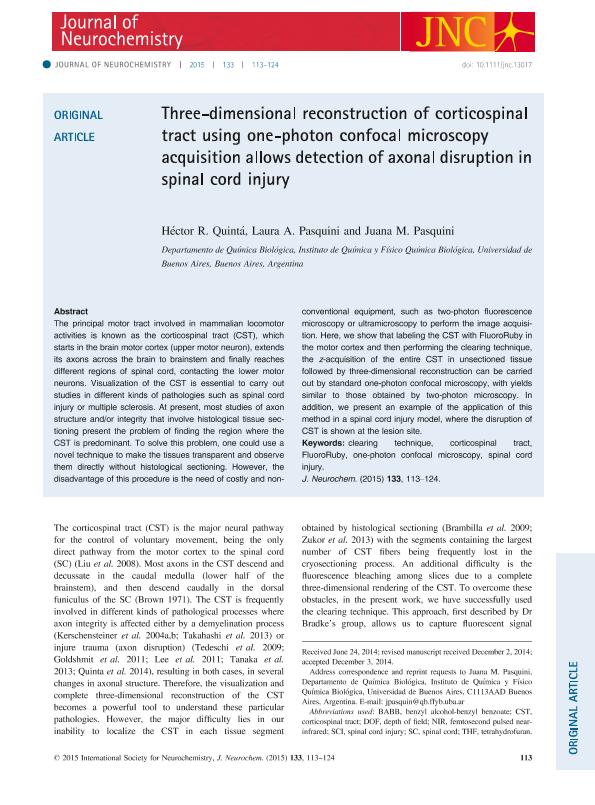Mostrar el registro sencillo del ítem
dc.contributor.author
Quintá, Héctor Ramiro

dc.contributor.author
Pasquini, Laura Andrea

dc.contributor.author
Pasquini, Juana Maria

dc.date.available
2017-06-09T21:28:46Z
dc.date.issued
2014-04
dc.identifier.citation
Quintá, Héctor Ramiro; Pasquini, Laura Andrea; Pasquini, Juana Maria; Three-dimensional reconstruction of corticospinal tract using one-photon confocal microscopy acquisition allows detection of axonal disruption in spinal cord injury; Wiley; Journal of Neurochemistry; 133; 1; 4-2014; 113-124
dc.identifier.issn
0022-3042
dc.identifier.uri
http://hdl.handle.net/11336/17955
dc.description.abstract
The principal motor tract involved in mammalian locomotor activities is known as the corticospinal tract (CST), which starts in the brain motor cortex (upper motor neuron), extends its axons across the brain to brainstem and finally reaches different regions of spinal cord, contacting the lower motor neurons. Visualization of the CST is essential to carry out studies in different kinds of pathologies such as spinal cord injury or multiple sclerosis. At present, most studies of axon structure and/or integrity that involve histological tissue sectioning present the problem of finding the region where the CST is predominant. To solve this problem, one could use a novel technique to make the tissues transparent and observe them directly without histological sectioning. However, the disadvantage of this procedure is the need of costly and non-conventional equipment, such as two-photon fluorescence microscopy or ultramicroscopy to perform the image acquisition. Here, we show that labeling the CST with FluoroRuby in the motor cortex and then performing the clearing technique, the z-acquisition of the entire CST in unsectioned tissue followed by three-dimensional reconstruction can be carried out by standard one-photon confocal microscopy, with yields similar to those obtained by two-photon microscopy. In addition, we present an example of the application of this method in a spinal cord injury model, where the disruption of CST is shown at the lesion site.
dc.format
application/pdf
dc.language.iso
eng
dc.publisher
Wiley

dc.rights
info:eu-repo/semantics/openAccess
dc.rights.uri
https://creativecommons.org/licenses/by-nc-sa/2.5/ar/
dc.subject
One Photon Confocal Microscopy
dc.subject
Spinal Cord Injury
dc.subject
Clearing Technique
dc.subject
Corticospinal Tract
dc.subject
Fluororuby
dc.subject.classification
Neurociencias

dc.subject.classification
Medicina Básica

dc.subject.classification
CIENCIAS MÉDICAS Y DE LA SALUD

dc.title
Three-dimensional reconstruction of corticospinal tract using one-photon confocal microscopy acquisition allows detection of axonal disruption in spinal cord injury
dc.type
info:eu-repo/semantics/article
dc.type
info:ar-repo/semantics/artículo
dc.type
info:eu-repo/semantics/publishedVersion
dc.date.updated
2017-06-09T15:01:09Z
dc.journal.volume
133
dc.journal.number
1
dc.journal.pagination
113-124
dc.journal.pais
Estados Unidos

dc.journal.ciudad
Hoboken
dc.description.fil
Fil: Quintá, Héctor Ramiro. Consejo Nacional de Investigaciones Científicas y Técnicas. Oficina de Coordinación Administrativa Houssay. Instituto de Química y Físico-Química Biológicas "Prof. Alejandro C. Paladini". Universidad de Buenos Aires. Facultad de Farmacia y Bioquímica. Instituto de Química y Físico-Química Biológicas; Argentina
dc.description.fil
Fil: Pasquini, Laura Andrea. Consejo Nacional de Investigaciones Científicas y Técnicas. Oficina de Coordinación Administrativa Houssay. Instituto de Química y Físico-Química Biológicas "Prof. Alejandro C. Paladini". Universidad de Buenos Aires. Facultad de Farmacia y Bioquímica. Instituto de Química y Físico-Química Biológicas; Argentina
dc.description.fil
Fil: Pasquini, Juana Maria. Consejo Nacional de Investigaciones Científicas y Técnicas. Oficina de Coordinación Administrativa Houssay. Instituto de Química y Físico-Química Biológicas "Prof. Alejandro C. Paladini". Universidad de Buenos Aires. Facultad de Farmacia y Bioquímica. Instituto de Química y Físico-Química Biológicas; Argentina
dc.journal.title
Journal of Neurochemistry

dc.relation.alternativeid
info:eu-repo/semantics/altIdentifier/url/http://onlinelibrary.wiley.com/doi/10.1111/jnc.13017/abstract
dc.relation.alternativeid
info:eu-repo/semantics/altIdentifier/doi/http://dx.doi.org/10.1111/jnc.13017
Archivos asociados
